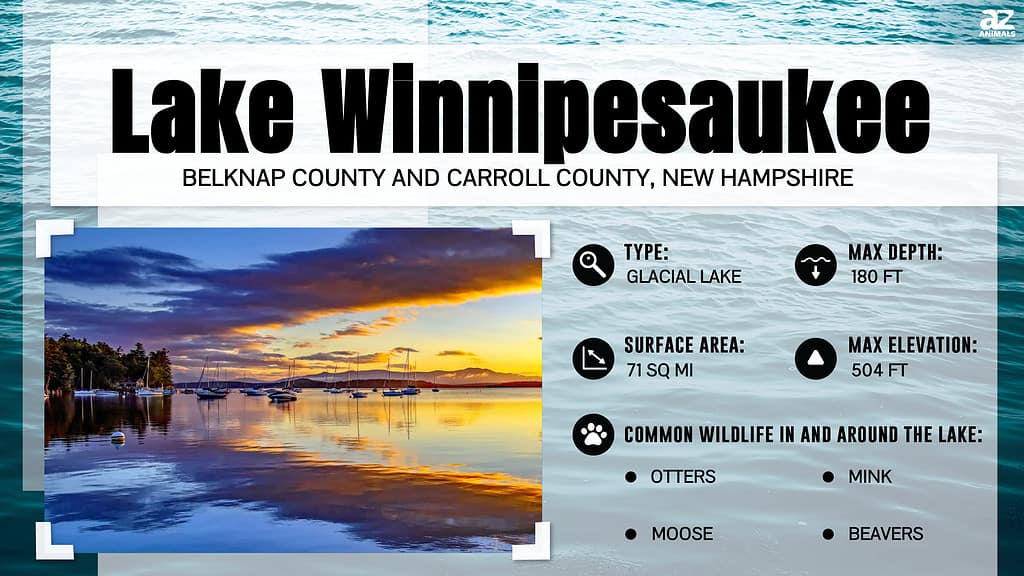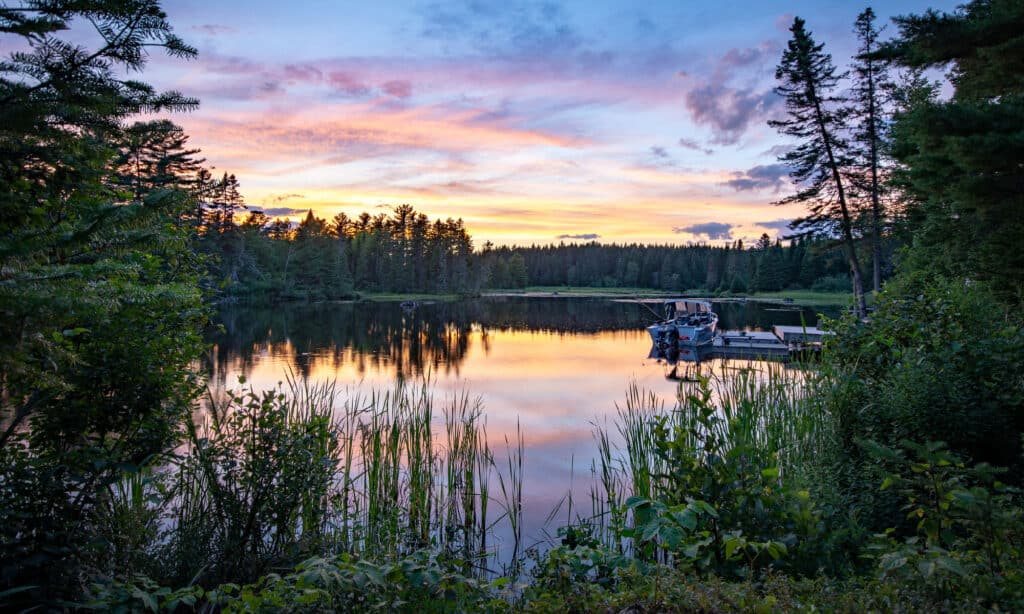The U.S. Northeast is a beautiful region of mountains, forests, rivers, and lakes. Some of these lakes possess some of the most transparent water in the country and can be pretty wide. One of these lakes is Lake Winnipesaukee in New Hampshire. Just how wide is Lake Winnipesaukee?
Facts About Lake Winnipesaukee

Lake Winnipesaukee is the largest lake in New Hampshire, between Belknap and Carrol counties, with a surface area of 71 square miles. It is also the sixth-largest natural lake in the United States and a locale of unrivaled beauty. The lake, nestled among the mountains and woodlands of New England, has sparkling, clear water and abundant wildlife. Its nearly 365 islands provide an exciting backdrop for swimming, fishing, and sailing.
The Maximum Width of Lake Winnipesaukee

Lake Winnipesaukee is the largest lake in New Hampshire, but how wide is it?
©iStock.com/Gerry Fagan
Lake Winnipesaukee is a vast lake measuring 9 miles across at its widest point. It’s 20.8 miles long and has 365 islands accounting for 288 miles of shoreline. It is one of the largest lakes in New England.
How Long It Would Take the Average Swimmer to Swim Across Lake Winnipesaukee
Although Lake Winnipesaukee is 9 miles across at its widest point, it is littered with islands. A swimmer would have to swim 10.21 miles to navigate the path through these islands. At 2 mph, it would take an average swimmer 5 hours and 6 minutes to swim. For comparison’s sake, a marathon swim is considered to be over 6 miles. This would be a little more than the distance of Mexico’s Sumidero Canyon Swimming Marathon, which is about 9.32 miles.

An average swimmer would take just over 5 hours to cross Lake Winnipesaukee.
©iStock.com/master1305
Things to Do Around Lake Winnipesaukee
It’s no surprise that there is a wealth of things to do around Lake Winnipesaukee. There are several boating access ramps all along the lakeshore. You can take a cruise, rent, charter, or bring your boat.
The lake’s selection of salmon, trout, bass, pickerel, smelt, and bluegill provides some of the best fishing in New England. The Meredith Rotary Club also sponsors an annual fishing derby with substantial cash prizes.
There are swimming beaches, hiking trails, and biking trails ranging from 11 to 52 miles long. Ellacoya State Park in Gilford is on the lake’s southern shore.
The fun doesn’t stop in winter, either. Lake Winnipesaukee is a popular destination for ice fishing and other winter activities, such as skiing, snowmobiling, ice skating, and snowshoeing.
In addition to activities on the lake, several small towns around the waterfront provide entertainment.
Wildlife Around Lake Winnipesaukee
Of course, Lake Winnipesaukee provides excellent fishing with a staggering diversity of species, but you can also find a vast array of other wildlife in this pristine New Hampshire region.
Large Mammals
Throughout the forests and on the mountains, many large mammals reside in the Lake Winnipesaukee region, including black bears, bobcats, coyotes, red and gray foxes, moose, and wolves. There is an abundance of smaller prey to support them.
Small Mammals
The number of small mammals throughout this region is impressive, with a diversity that includes mice, rabbits, lemmings, shrews, raccoons, skunks, opossums, porcupines, flying squirrels, otters, muskrats, beavers, and bats. There is also a resurgence in the area of fisher cats, also known as fishers, which are nocturnal hunters resembling a cross between a weasel and a cat. They were nearly extinct but are now found throughout the region.

The fisher, once near extinction, hunts small prey around Lake Winnipesaukee.
©Reimar/Shutterstock.com
Birds
Given the presence of such a pristine lake with abundant surrounding forest, it’s no wonder birds can be found in great numbers at Lake Winnipesaukee. Of course, there are several waterfowl and shorebirds, including loons, mallards, black-headed gulls, piping plovers, great blue herons, and snowy egrets. There are also many other interesting species, such as the golden eagle, ring-necked pheasant, ruffed grouse, eastern bluebird, ruby-crowned kinglet, hermit thrush, indigo bunting, and dark-eyed junco.
Reptiles and Amphibians
Reptiles and amphibians abound, with salamanders, mudpuppies, frogs, and turtles, as well as a variety of snakes, including timber rattlesnakes, common garter snakes, and redbelly snakes. The redbelly snake is small (under 10 inches long) with a unique coloring—black with a red underbelly. Such a boldly colored snake would appear dangerous, but that couldn’t be further from the truth: redbellies are not venomous, feeding on worms and slugs.
Comparison of Lake Winnipesaukee to Other Lakes
The Northeast region of the U.S. is home to many states with lakes. In addition to Lake Winnipesaukee, there are several large lakes in New Hampshire and New England in general.
Other Big Lakes in New Hampshire
Umbagog Lake
Umbagog Lake has a width of 1.9 miles and an area of 12.26 square miles. It is the second-largest lake on the border of Maine and New Hampshire. The lake has an abundance of wildlife, including black bears, moose, foxes, and beavers, and is an excellent destination for boating, fishing, swimming, and wildlife viewing.
Squam Lake
New Hampshire’s third-largest lake, Squam Lake, is located in southern New Hampshire and has a surface area of 10.6 square miles and a width of 4.6 miles. With some of the cleanest water in the country, this lake has 67 islands and is host to the Squam Lakes Natural Science Center. Here, you will find many habitats, including marshes, forests, and meadows, where black bears, bobcats, mountain lions, river otters, raptors, and more reside.
Newfound Lake
Another New Hampshire Lake, Newfound Lake, is 2.4 miles wide. It has a surface area of about 7 square miles and is considered the state’s fourth-largest lake. This pristine lake is the deepest in New Hampshire, with a depth of 183 feet at its deepest point. The region is a hiker’s dream, with massive vistas and state park trails. Wellington State Park also provides opportunities for swimming and fishing, with 22 different species of fish found within the watershed.
Larger Lakes in New England
Lake Champlain
Lake Champlain is an incredible 14 miles wide at its widest point and has a surface area of 490 square miles, most of which is in Vermont, though it also borders New York and the Canadian province of Quebec. The lake is nestled between the Adirondacks and the Green Mountains, and the largest city on its shores is the Vermont city of Burlington. Lake Champlain is an excellent spot for boating and camping. It is also ideal for fishing, as it is considered one of the best bass fishing lakes in the Northeast.
Moosehead Lake
Moosehead Lake is the second largest lake in New England, with a surface area of 118 square miles. It is 10 miles wide and has a maximum depth of 246 feet. This coldwater lake is the source of the Kennebec River and is situated in the Longfellow Mountains. The lake is dotted with over 80 islands, with Sugar Island as the largest. Moosehead Lake is an excellent island for ice fishing, with abundant brook trout, lake trout, and landlocked salmon.

Moosehead Lake, the second largest lake in New England, is slightly wider than Lake Winnipesaukee at over 10 miles.
©iStock.com/mountinez
Summary
So, not only do we know that New Hampshire’s Lake Winnipesaukee is 9 miles wide. We also learned a little about the lake itself. We learned about the activities that are available there, the kinds of wildlife you can find there, and how other lakes in the region compare. This lake is truly a gem of New England!
The photo featured at the top of this post is © iStock.com/Gerry Fagan
Thank you for reading! Have some feedback for us? Contact the AZ Animals editorial team.







